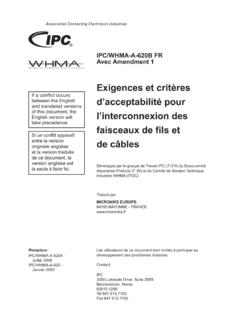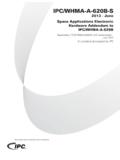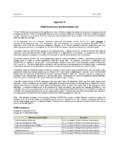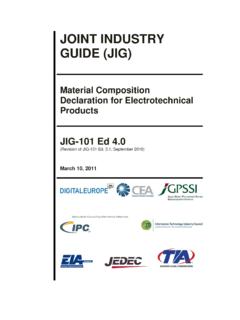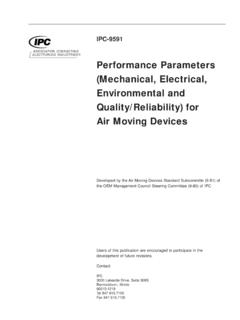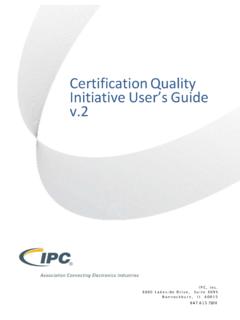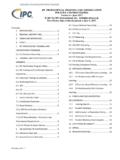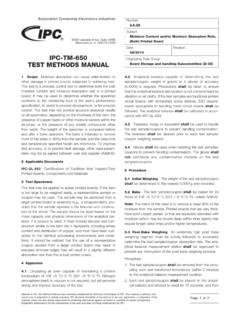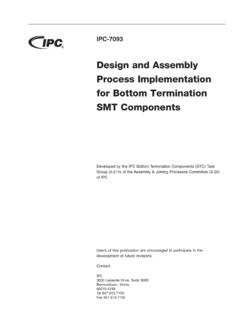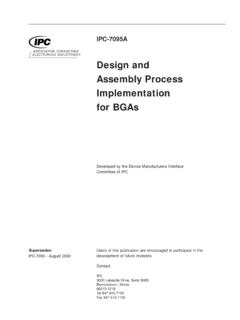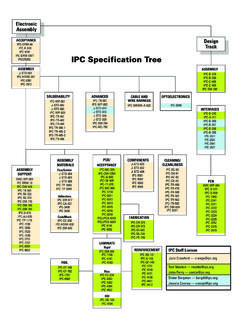Transcription of ASSOCIATION CONNECTING ELECTRONICS …
1 ASSOCIATION CONNECTING . ELECTRONICS INDUSTRIES . IPC- 4552 . Amendment 1. Specification for Electroless Nickel/Immersion Gold (ENIG) Plating for Printed Circuit Boards IPC- 4552 . Amendment 1. June 2012 A standard developed by IPC. 3000 Lakeside Drive, Suite 309S, Bannockburn, IL 60015-1249. Tel. Fax The Principles of In May 1995 the IPC's Technical Activities Executive Committee (TAEC) adopted Principles of Standardization Standardization as a guiding principle of IPC's standardization efforts. Standards Should: Standards Should Not: Show relationship to Design for Manufacturability Inhibit innovation (DFM) and Design for the Environment (DFE) Increase time-to-market Minimize time to market Keep people out Contain simple (simplified) language Increase cycle time Just include spec information Tell you how to make something Focus on end product performance Contain anything that cannot Include a feedback system on use and be defended with data problems for future improvement Notice IPC Standards and Publications are designed to serve the public interest through eliminating mis- understandings between manufacturers and purchasers, facilitating interchangeability and improve- ment of products, and assisting the purchaser in selecting and obtaining with minimum delay the proper product for his particular need.
2 Existence of such Standards and Publications shall not in any respect preclude any member or nonmember of IPC from manufacturing or selling products not conforming to such Standards and Publication, nor shall the existence of such Standards and Publications preclude their voluntary use by those other than IPC members, whether the standard is to be used either domestically or internationally. Recommended Standards and Publications are adopted by IPC without regard to whether their adop- tion may involve patents on articles, materials, or processes. By such action, IPC does not assume any liability to any patent owner, nor do they assume any obligation whatever to parties adopting the Recommended Standard or Publication. Users are also wholly responsible for protecting them- selves against all claims of liabilities for patent infringement.
3 IPC Position It is the position of IPC's Technical Activities Executive Committee that the use and implementation Statement on of IPC publications is voluntary and is part of a relationship entered into by customer and supplier. Specification When an IPC publication is updated and a new revision is published, it is the opinion of the TAEC. Revision Change that the use of the new revision as part of an existing relationship is not automatic unless required by the contract. The TAEC recommends the use of the latest revision. Adopted October 6, 1998. Why is there Your purchase of this document contributes to the ongoing development of new and updated indus- a charge for try standards and publications. Standards allow manufacturers, customers, and suppliers to under- this document?
4 Stand one another better. Standards allow manufacturers greater efficiencies when they can set up their processes to meet industry standards, allowing them to offer their customers lower costs. IPC spends hundreds of thousands of dollars annually to support IPC's volunteers in the standards and publications development process. There are many rounds of drafts sent out for review and the committees spend hundreds of hours in review and development. IPC's staff attends and par- ticipates in committee activities, typesets and circulates document drafts, and follows all necessary procedures to qualify for ANSI approval. IPC's membership dues have been kept low to allow as many companies as possible to participate. Therefore, the standards and publications revenue is necessary to complement dues revenue.
5 The price schedule offers a 50% discount to IPC members. If your company buys IPC standards and publications, why not take advantage of this and the many other benefits of IPC membership as well? For more information on membership in IPC, please visit or call 847/597-2872. Thank you for your continued support. Copyright 2012. IPC, Bannockburn, Illinois, USA. All rights reserved under both international and Pan-American copyright conventions. Any copying, scanning or other reproduction of these materials without the prior written consent of the copyright holder is strictly prohibited and constitutes infringement under the Copyright Law of the United States. June 2012 IPC- 4552 - Amendment 1. Specification for Electroless Nickel/Immersion Gold (ENIG) Plating for Printed Circuit Boards Replace Table 3-1 and footnote with the following: Table 3-1 Requirements of Electroless Nickel/Immersion Gold Plating Requirement Tests Test Method Paragraph Class 1 Class 2 Class 3.
6 General Uniform plating and complete Visual Visual coverage of surface to be plated Electroless Nickel Thickness APPENDIX 4 3 to 6 m [ to in]. The minimum immersion gold deposit thickness shall Immersion Gold Thickness be m [ in] at -4 sigma from the mean APPENDIX 4 (Default for this IPC standard) as measured on a pad size of mm x mm [ in x in] or equivalent area. The minimum immersion gold deposit thickness shall Immersion Gold Thickness be m [ in] at -4 sigma from the mean (Exception required on APPENDIX 4 as measured on a pad size of mm x mm procurement documentation). [ in x in] or equivalent area. Porosity N/A N/A. Physical IPC-TM-650, Adhesion/Tape Test No evidence of plating removed TM Meet solderability requirements of Category 3. Solderability(2) J-STD-003 durability with 6 months shelf life.
7 Chemical ASTM B733-97. (Reference Only; Supplier Dependent - Phosphorous/Boron Content & ASTM No Testing Required). B607-91(1998). Chemical Resistance N/A N/A. Electrical (1). High Frequency Signal Loss TBD. (1). Contact Resistance TBD. Environmental IPC-TM-650, Cleanliness Max. g/cm2. TM (1). An appropriate IPC-TM-650 test method used to generate data for this electrical property is not available at the time of this writing. (2). This applies to the default Immersion Au thickness, only. 1. IPC- 4552 - Amendment 1 June 2012. Replace Section with the following: Setup and measurement methodologies are crucial for accuracy (see APPENDIX 4 for recommended measure- Electroless Nickel Thickness The electroless ment techniques). nickel thickness shall be 3 m to 6 m [118 in to 236 in].
8 As measured on a nominal pad size of mm x mm NOTE: The same considerations apply for gold thickness [ in x in] or equivalent area, where standard measurements and their relationship to pad size as applied feature size tolerances as expressed in the IPC-6010 stan- to the electroless nickel deposition thickness. Due to the dard series, apply. importance of control of immersion gold deposit thickness, it is imperative to have all parties measure the same feature NOTE: Some designs may not have feature sizes of this size which may likely require discussion and agreement specified pad area and will require the use of alternate pad between user and supplier. sizes. The XRF collimator used shall always be smaller than the pad used for measurement; and specifically, the ENIG Category 2 Coating Durability per IPC.
9 Collimator shall not exceed 30% of the feature pad size J-STD-003 (This is for Soldering Applications ONLY). being measured. For smaller sized pads, the measurement The minimum immersion gold deposit thickness shall be time will need to increase proportionately as a function of m ( in) at -4 sigma from the process mean as collimator size reduction. Consistency of pad size measure- measured on a pad size of mm x mm [ in x ment is of primary concern in order to obtain a statistically in] or equivalent area, where standard feature size valid result due to the general plating deposit variation seen tolerances as expressed in the IPC-6010 standard series, as a function of pad size. That is, smaller features will plate apply. The use of this reduced gold thickness shall require thicker than larger features.
10 The use of fiducial pads for this the following specific notation on the procurement docu- measurement is suggested for designs not having the speci- mentation: The gold thickness to be per Amendment 1. fied pad feature areas, as above. to IPC- 4552 , section ''. NOTE: Pad size concerns apply here as in and Replace Section with the following: Immersion Gold Thickness The following four provisions shall be met for Soldering ENIG Category 3 Coating Durability per IPC. Applications ONLY'' before the ENIG plating reduction is allowed to be implemented: J-STD-003 (This is the Default Gold Thickness) The minimum immersion gold thickness shall be m 1. Due to the reduced gold thickness, the printed boards [ in] at -4 sigma (standard deviation) from the mean shall be used within six months of date of manufacture.
